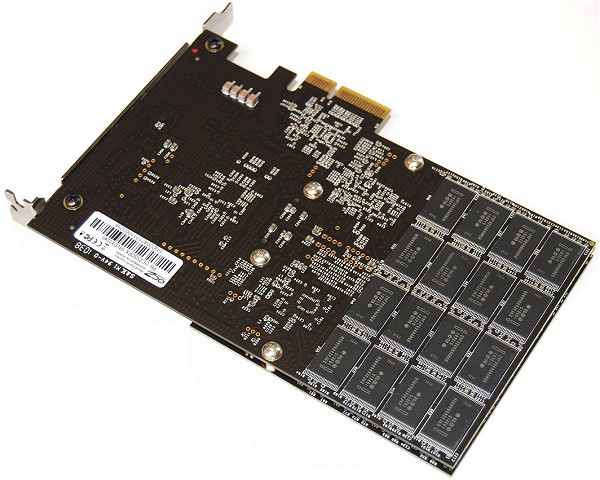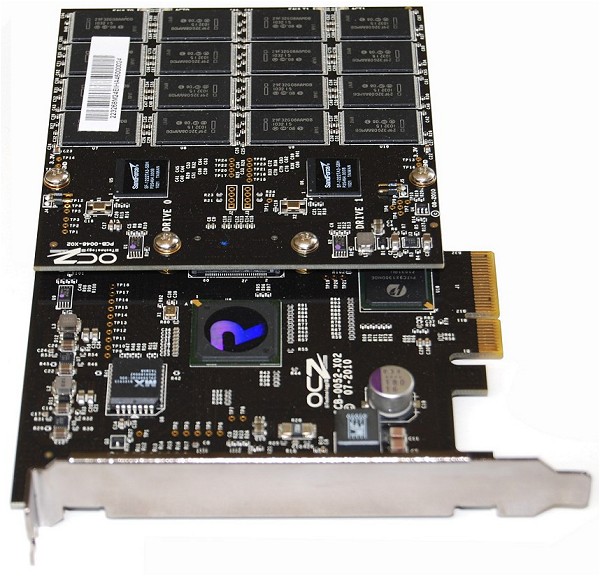OCZ RevoDrive X2 240GB in Detail
As mentioned earlier, the OCZ RevoDrive X2 is available in different capacities. We have the 240GB ($680) version, but there's also 100GB ($460), 160GB ($550), 360GB ($1,160), 480GB ($1,440) and 960GB ($3,360) models.
There's no nice way to say it: the RevoDrive X2 drives are expensive. Our 240GB review sample carries a retail tag of $680, enough to buy you two netbooks or a budget laptop with more storage capacity.

Of course, for this price you are getting four SandForce SF-1200 controllers in RAID0. By comparison four Vertex 2 60GB drives would cost at least $550 making the RevoDrive X2 240GB considerably more expensive. On the other hand, the RevoDrive offers a much more convenient way to go about RAID0. Four Vertex 2 drives require four SATA ports supporting RAID that are connected to a high performance chipset, the RevoDrive X2 simply requires a single PCI Express x4 slot.


The RevoDrive X2 is an entirely self-contained unit and this has both positive and negative angles. While it doesn't require any power or data cables, you're essentially putting all your eggs in one basket. If one of the controllers or NAND flash memory chips were to fail, the entire drive would become useless. With four separate drives, if one of them fails you need only replace the dead drive – though, you'd likely still lose all your data if using RAID0.

In terms of performance, users are looking at a claimed read and write throughput of 740MB/s and 720MB/s for the 240GB - 960GB models. The 100GB - 160GB models claim the same impressive read performance, but writes are reduced to 690MB/s.
The four SandForce SF-1200 controllers are connected internally using the four-port Silicon Image Sil3124 RAID controller which, to our surprise, is PCI-X-based. The RevoDrive X2 can use PCIe x4 courtesy of the Pericom PCI-X to PCIe bridge chip, which converts the parallel PCI-X signaling into serial PCIe.


The advantage to using PCIe x4 opposed to the SATA interface is that it provides far more bandwidth. The Serial ATA 3Gb/s bus is only capable of connecting devices at transfer speeds of about 300MB/s. The RevoDrive X2 uses the PCI Express 4x bus which allows speeds of up to 1GB/s.

The Sil3124 controller can feed 1GB/s of bandwidth to the Pericom bridge while the PCI Express 4x bus can move up to 1GB/s of data in either direction, meaning there are no bottlenecks. Given that the RevoDrive X2 is said to max out at around 740MB/s, this configuration allows the SandForce SF-1200 controllers to perform at their fullest.
It's worth noting that when using any SSDs in RAID, the TRIM function won't work. This is true with the OCZ RevoDrive X2, which doesn't support TRIM due to its implementation of RAID0. Given that TRIM is designed to maintain optimal performance, the RevoDrive X2 must rely on idle garbage collection to retain its 'like-new' performance.
Another key aspect of the RevoDrive X2 is its ability to be used as a boot drive. Using the supplied drivers, users can allow the Windows installation to detect and install onto the RevoDrive X2 which we did successfully when testing real-world performance.

The RevoDrive X2 measures 181.07mm long x 21.59mm wide x 125.08mm high and weighs roughly 171g. The MTBF (Mean Time Between Failures) has been increased to two million hours, which is considerably higher than most SSDs we've reviewed. The typical 1500g vibration resistance rating applies, while OCZ claims that the RevoDrive X2 uses just 3 watts of power at idle and 8 watts when active. OCZ backs the drive with a three-year warranty.
